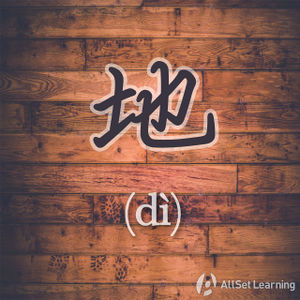Difference between revisions of "Turning adjectives into adverbs"
| Line 17: | Line 17: | ||
*你 要 <em>努力</em> <strong>地</strong> 学习 。<span class="pinyin">Nǐ yào <em>nǔlì</em> <strong>de</strong> xuéxí.</span><span class="trans">You must study hard.</span> | *你 要 <em>努力</em> <strong>地</strong> 学习 。<span class="pinyin">Nǐ yào <em>nǔlì</em> <strong>de</strong> xuéxí.</span><span class="trans">You must study hard.</span> | ||
| − | *雨天 地 滑 ,<em> | + | *雨天 地 滑 ,<em>慢 慢</em> <strong>地</strong> 走 。<span class="pinyin">Yǔtiān dì huá, <em>màn màn</em> <strong>de</strong> zǒu.</span><span class="trans">The floor is very slippery in rainy days. Walk slowly.</span> |
*小猫 <em>舒服</em> <strong>地</strong> 躺 在 那里 。<span class="pinyin">Xiǎomāo <em>shūfu</em> <strong>de</strong> tǎng zài nàlǐ.</span><span class="trans">The kitten is comfortably lying down here.</span> | *小猫 <em>舒服</em> <strong>地</strong> 躺 在 那里 。<span class="pinyin">Xiǎomāo <em>shūfu</em> <strong>de</strong> tǎng zài nàlǐ.</span><span class="trans">The kitten is comfortably lying down here.</span> | ||
*小狗 在 <em>大声</em> <strong>地</strong> 叫 。<span class="pinyin">Xiǎogǒu zài <em>dàshēng</em> <strong>de</strong> jiào.</span><span class="trans">The puppy is barking loudly.</span> | *小狗 在 <em>大声</em> <strong>地</strong> 叫 。<span class="pinyin">Xiǎogǒu zài <em>dàshēng</em> <strong>de</strong> jiào.</span><span class="trans">The puppy is barking loudly.</span> | ||
Revision as of 08:19, 2 November 2017
-
Level
-
Similar to
-
Used for
-
Keywords
You can easily convert Chinese adjectives into adverbs with 地 (de). This character is very similar to the English suffix -ly.
Structure
In Chinese, we place the structural particle 地 (de) after the adjective to make it an adverb.
Subj. + Adj. + 地 + Verb
Examples
- 你 要 努力 地 学习 。You must study hard.
- 雨天 地 滑 ,慢 慢 地 走 。The floor is very slippery in rainy days. Walk slowly.
- 小猫 舒服 地 躺 在 那里 。The kitten is comfortably lying down here.
- 小狗 在 大声 地 叫 。The puppy is barking loudly.
- 我 希望 你 快快乐乐 地 长大 。I hope that you grow up happily.
See Also
Sources and further reading
Books
- Basic Patterns of Chinese Grammar (pp. 72) →buy
- Integrated Chinese: Level 2, Part 1 (pp. 192) →buy



